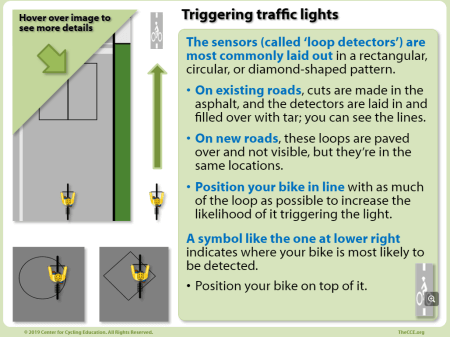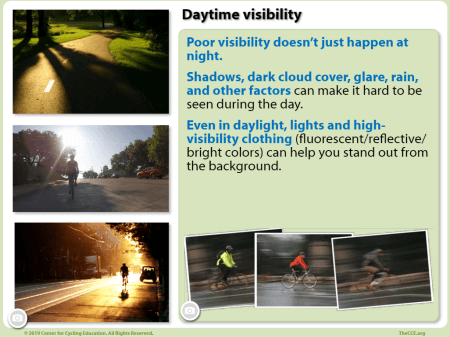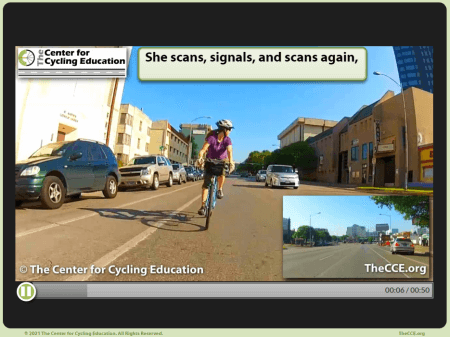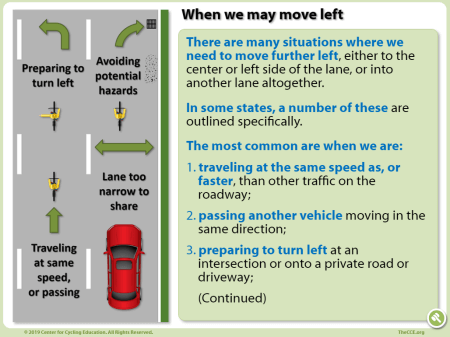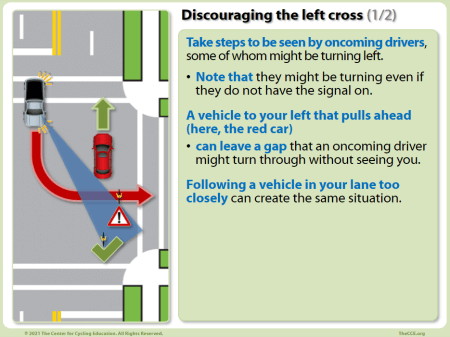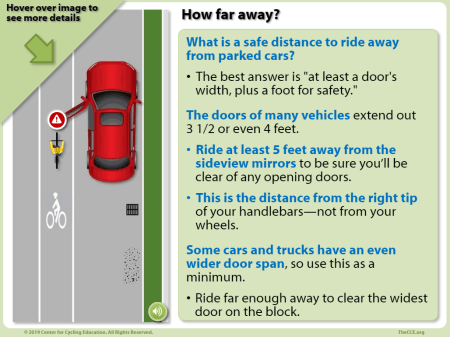Online ticket dismissal course for cyclists
Available for implementation anywhere in the USA and Canada.
Contact us for details.
Did you receive a traffic ticket while riding your bike?
• Have your fine waived and get your citation dismissed by taking this worthwhile course.
We want to help.
If you believe you were ticketed wrongly, or were targeted by police because of your race or for another illegitimate reason, please contact us.
We will provide you access to the course at no cost. The content will provide valuable resources in contesting your case.
As well, we will work with you at no cost to locate an attorney in your area who is experienced and skilled at defending cyclists.
Since July of 2010, we have been offering an option to cyclists that has been available to drivers for years – having a traffic ticket waived in exchange for taking part in valuable, effective training.
With this course you will find ways to avoid getting another citation, become more skilled at riding in traffic, and gain more comfort on the road. Valuable for cyclists of all experience levels.
"This is such an excellent resource. I’ve been commuting to school/work for 12 years and consider myself to be a pretty good rider, but I learned so much here. I’ve read plenty of things online and even a few books, but this addressed a lot of concerns I had and presented new info in a way that’s easy to comprehend (the graphics and videos helped a lot).
I liked that I could go back in when I wanted and it kept my place.
I’ve been trying out what I learned on my rides this week, and it’s already making a big difference. Thanks!"
— Stephen R.
Why take the Defensive Cycling course?
By successfully completing it, you will:
- Meet the requirements to have your fine waived by the court and your traffic ticket dismissed. (Note: you still need to pay your court fee and associated costs.)
- Keep the offense from being applied to your driving record in error.*
- Gain valuable techniques that will help you increase your competence and confidence in traffic, even if you are an experienced cyclist.
- Learn the laws that apply to you as a cyclist, reducing the likelihood of getting a future ticket.
Hello Allan,
Thank you for the heads-up [procedures for dismissing a ticket], the great service and course. I am glad I learned about it from a friend. I have to say that I learned a lot from the course and I now feel I am a safer rider.
Thanks again!
— Nikos B.
Here’s how you can take part in this ‘ticket dismissal’ option:
Cost: $35
Time: Approximately 5 hours
- Complete and submit a Deferred Disposition form through the court, along with the payment of the court fee and any other associated charges.
- Sign up for the online course (choose your location):
- Complete the course with a passing grade.
- A Certificate of Completion will be prepared and emailed directly to the court, or sent to you to deliver to the court (depending on the jurisdiction).
- Once the certificate is processed, the fine will be waived and the ticket dismissed.
Important: Be sure to read the Terms and Conditions regarding your participation in the course.
Ticket dismissal course – important information
- In order for a certificate to be issued, you must provide your complete and correct Court case (’cause’) number.
- Austin: ‘AMC’ followed by an 8-digit number (sometimes followed by ‘A’) — e.g., AMC########A (Search for your case number here.)
- Houston: 4-digit year + ‘TR’ + 7-digit number — e.g., 2024TR#######
- San Marcos: 4-digit year + 6-digit number — e.g., 2024######
- Travis County: ‘J5-CR’ (‘Justice of the Peace, Precinct 5’) + 2-digit year + 6-digit number — e.g., J5-CR-24######
- Waller County: ‘T’ + two-digit year + 4-digit number + JP1 — e.g., T24-####-JP1
- No later than 7 days before the deadline for Austin or Houston.
- No later than 14 days before the deadline for Travis County or San Marcos. See below for details.
- Austin, Houston and Waller County, TX: A PDF version of the certificate will be emailed directly to the Court. You will be copied on this email.
- Travis County & San Marcos, TX: A PDF version of the certificate along with an accompanying letter will be emailed to you, which you must print out (the certificate must be in color) and mail or take in to the Court.
If you have any questions at all, please feel free to contact us by email, phone or text.
Here are the laws that apply to you as a cyclist, including your rights:
From the Texas Transportation Code:
Sec. 551.101. RIGHTS AND DUTIES.
(a) A person operating a bicycle has the rights and duties applicable to a driver operating a vehicle under this subtitle, unless:
(1) a provision of this chapter alters a right or duty; or
(2) a right or duty applicable to a driver operating a vehicle cannot by its nature apply to a person operating a bicycle.
(b) A parent of a child or a guardian of a ward may not knowingly permit the child or ward to violate this subtitle.
- Texas Transportation Code, Chapter 551:
Operation of Bicycles and Mopeds, Golf Carts, and Other Low-Powered Vehicles- Texas Transportation Code, All sections
(Look for Title 7 – Vehicles and Traffic, Subtitle C: Rules of the Road)- Austin Cycling Bylaws: Austin City Code, Chapter 12-2. Bicycles
- Austin’s Safe Passing / Vulnerable Road Users Ordinance
Here is what is explored in the course:
Being an MVP-C
Being an MVP-C
- What does this mean?
- Manoeuvrable: Creating space around you
- Visible: Being seen, day and night
- Overview
- Daytime visibility
- Nighttime visibility
- Lights & lighting configurations
- Clothing
- Predictable: Helping others make the right decisions
- Set up mutual communication
- Make your own decisions
- Know what’s coming
- Give advance notice
- Other ways to make it easier
- Communicative: Getting across the right messages
- Overview
- What do we need to communicate?
- How can we communicate?
- Lane choice & lane positioning
- Hand signals, higher cadence, eye contact, sound
- Think people, not cars
- Making it positive
- Putting it all together: MVP-C
Equipment
Equipment
Optional: Parts of the bike
Checking your bike for safety
- ABC Quick Check
- A more detailed check
- ‘Do it yourself’ vs. ‘Let them do it’
Sizing, configuring, & adjusting your bike
- Checking for fit
- 1) Frame size
- 2) Saddle height
- 3) Saddle position: forward/back/tilt
- 4) Handlebar position
- Making adjustments
Required & optional equipment
- Brakes
- Lighting
- What’s needed, and when
- Lights & lighting configurations
- Reflectors & reflective materials
- Using more than the basics
- Helmets
- Overview
- Choosing a helmet
- Wearing it right
- Putting the helmet on
- Checking that it’s the proper size
- Including fixed-gear bikes (‘fixies’)
Parking your bike
- Deterring bike theft
- Where to park your bike
- How to lock it up
- What kind of locks?
- Just in case… (insurance & registration with police)
Bike handling skills
Bike handling skills
Braking
- Practicing out of traffic
- Using the right touch
- Covering the brakes
- A two-step method
- The front brake, & how much
- If the rear wheel skids
- Both hands on the bar
- Planning ahead
- Brake on clean surfaces
- Slippery when wet
- Dry the brakes in wet conditions
Pedalling at a higher cadence (RPM)
- Physical benefits
- Communication benefits
- How fast should you pedal?
Riding in a straight line
- Three key elements
Scanning behind
- Getting a 360° view
- Steps to make it easier
- Practicing the technique
- Refining the technique
Optional section: Shifting gears
- What do we mean by ‘gears’?
- The purpose of shifting
- Derailleurs
- How many gears does my bike have?
- Choosing a gear
- What gear am I in?
- When to shift: speeding up/going downhill
- When to shift: slowing down/climbing hills
- Shifting: front vs. back
- Shifting: front & back at same time
- Reducing wear on gears & chain
- If the chain comes off
How people behave in traffic
How people behave in traffic
- Your reaction to other people’s errors
- Video: It’s a 3-Way Street
- How do these behaviours come about?
- Your attitude and its impact
- Monitoring your thoughts
- Evaluating your skills
- Learning from your experiences
Your rights & duties
Your rights & duties
Knowing your true place in traffic
- The same rights & duties
- “But you don’t pay for the roads!” (Yes, we do.)
What’s the point of the law?
- Knowing what to expect
- Making decisions easier
- Demonstrating what we expect
- Our effect on other cyclists
- Deterrence & compensation
- Order & safety vs. convenience
- What a traffic ticket means to you
- The cost of a ticket
An overview of traffic laws
- Multiple levels of traffic laws
- Case law
- Where do these laws apply?
- How are the laws written?
- Drivers’ duties toward us
- Disclaimer
A summary of common cycling laws
- A quick snapshot
- Rights & duties of cyclists
- Operation of the bicycle
- Position on the road
- Sidewalk riding
- Signalling
- Riding side-by-side
- Equipment requirements
- Drugs & alcohol
- Other
- Bicycle as a vehicle
- Electric bikes
- Registration & licensing
- Parking
- Collision
Scanning & signalling
Scanning & signalling
Scanning for traffic
- Why it’s important
- Review of steps to make it easier
- When to scan
- Using mirrors
Signalling
- Why it’s important
- What we need to signal, and tips to make it easier
- Turns
- Lane changes
- Change of position within a lane
- Stops
- Pulling onto the roadway
- Waving thanks
- Signalling—how, and how often?
Putting it all together
- Scan, Signal, Scan, (if it’s safe) Go.
- How this looks in real life
Choosing your place on the road
Choosing your place on the road
Choosing a lane & lane position
- A reasoned approach
- Seeing things from a driver’s perspective
- Ride with traffic
- Risks of wrong-way riding
- How to choose your lane position
- Avoiding roadside hazards
- Giving ourselves space
- How far right?
- When you can move left
- Controlling the lane
- How this helps drivers
- What your options are
- Communicating with others
- Some important considerations
- Riding on one-way streets
- What does controlling the lane look like?
Parked cars
- The potential risks
- What’s a safe distance?
- Legal responsibility for drivers & passengers
- What a safe distance looks like
Bike lanes
- Do we have to ride in them?
- What are your options?
Intersections
Intersections
Lane position at intersections
- A, B or C position?
- Common driver errors at intersections, and how to discourage them
- Stopping at an intersection
- Positioning in bike lanes and at 4-way stops
- Travelling through the intersection
- If you ride in ‘C’ position
- If a driver turns across your path
- Regardless of what lane position you take…
- Right turn only lanes
When stopping is required
- Stop signs & red lights
- What might you miss?
- Go! No, stop!
- Fewer decisions are needed
- Drivers’ perceptions
- The cost of a ticket
- What is the point of the law?
- Where to stop
Right of way
- Don’t assume you have it
- First come, first served
- Yield to the person on the right
- Yield if you are turning
- Taking your turn
- Pedestrians’ right of way
- Which is a legal crosswalk?
- Communicate with others
Traffic lights
- Why a green light doesn’t mean ‘go’
- Judging the timing
- Starting off quickly
- Triggering traffic lights
Making turns
- Right turns
- Left turns
- Changing lanes: moving from ‘C’ position
- Changing lanes: with traffic around you
- Changing lanes: signalling
- Changing lanes: with no traffic around you
- Using the gaps
- Preparing for the turn
- Lane position for the turn
- Waiting position
- Making the turn
Traffic circles & roundabouts
- Efficient, but confusing for some
- Order of priority
- Go clockwise around the center
- Signal directly before you exit
- Video: How it looks in real life
Other riding situations
Riding:
- on sidewalks
- near buses & trucks
- side-by-side
- on paths & trails
Summary & feedback
Summary & feedback
- Includes an option for a brief survey so you can let us know what you think of the course.
The course significantly exceeds the traffic skills training requirements for the national programs in United States and Canada:
- League of American Bicyclists’ ‘Smart Cycling’ program
- Cycling Canada’s ‘CAN-BIKE’ program
More than 1500 people have taken the classroom or online course to dismiss a traffic ticket. Many others have taken our Traffic Smarts course out of general interest, to gain a pedicab license, or to meet training requirements for their employers.
The Center for Cycling Education developed all applicable training materials and administers the course training.
With more than 20 years’ experience as an instructor, the primary course developer has been both a Master Instructor with the League of American Bicyclists and a National Examiner with the Canadian Cycling Association (now Cycling Canada). Others with these credentials, and numerous instructors with each program, helped develop and review the content and delivery.
* Unless dismissed via a Defensive Driving or Defensive Cycling course, all traffic citations received by many jurisdictions (including those received while riding a bike) are sent through to the Department of Public Safety (DPS) or equivalent state agency. Only citations received while driving a motor vehicle (moving violations) are supposed to be applied to one’s driving record. However, there are recorded instances where, through human error, a cycling ticket does end up on the record:
- Lack of notation on the ticket that the vehicle involved was a bicycle.
- Motor vehicle offense code entered on ticket instead of bicycle offense code.
- Improper processing of a bicycle-related citation at DPS as being a motor vehicle violation.
